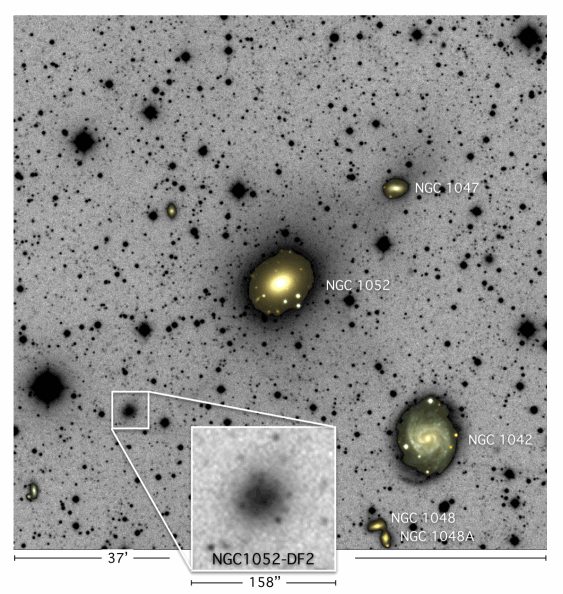The recent discovery of a galaxy, NGC1052-DF2, with no or almost no dark matter made headlines worldwide.
 |
| Nature 555, 629–632 (29 March 2018) |
Somewhat paradoxically, it has been proclaimed by some as evidence that the dark matter paradigm prevails over theories of modified gravity. And, as usual, many of the arguments were framed in the context of dark matter vs. MOND, as if MOND was a suitable representative of all modified gravity theories. One example is a recent Quora question, Can we say now that all MOND theories is proven false, and there is really dark matter after all? I offered the following in response:
First of all, allow me to challenge the way the question is phrased: “all MOND theories”… Please don’t.
MOND (MOdified Newtonian Dynamics) is not a theory. It is an ad hoc, phenomenological replacement of the Newtonian acceleration law with a simplistic formula that violates even basic conservation laws. The formula fits spiral galaxy rotation curves reasonably well, consistent with the empirical Tully—Fisher law that relates galaxy masses and rotational velocities, but it fails for just about everything else, including low density globular clusters, dwarf galaxies, clusters of galaxies, not to mention cosmological observations.
MOND was given a reprieve in the form of Jacob Beckenstein’s TeVeS (Tensor—Vector—Scalar gravity), which is an impressive theoretical exercise to create a proper classical field theory that reproduces the MOND acceleration law in the weak field, low velocity limit. However, TeVeS suffers from the same issues MOND does when confronted with data beyond galaxy rotation curves. Moreover, the recent gravitational wave event, GW170817, accompanied by the gamma ray burst GRB170817 from the same astrophysical event, thus demonstrating that the propagation speed of gravitational and electromagnetic waves is essentially identical, puts all bimetric theories (of which TeVeS is an example) in jeopardy.
But that’s okay. News reports suggesting the death of modified gravity are somewhat premature. While MOND has often been used as a straw man by opponents of modified gravity, there are plenty of alternatives, many of them much better equipped than MOND to deal with diverse astrophysical phenomena. For instance, f(R) gravity, entropic gravity, Horava—Lifshitz gravity, galileon theory, DGP (Dvali—Gabadadze—Porrati) gravity… The list goes on and on. And yes, it also includes John Moffat’s STVG (Scalar—Tensor—Vector Gravity — not to be confused with TeVeS, the two are very different animals) theory, better known as MOG, a theory to which I also contributed.
As to NGC1052-DF2, for MOG that’s actually an easy one. When you plug in the values for the MOG approximate solution that we first published about a decade ago, you get an effective dynamical mass that is less than twice the visible (baryonic) mass of this galaxy, which is entirely consistent with its observed velocity dispersion.
In fact, I’d go so far as to boldly suggest that NGC1052-DF2 is a bigger challenge for the dark matter paradigm than it is for some theories of modified gravity (MOG included). Why? Because there is no known mechanism that would separate dark matter from stellar mass.
Compare this to the infamous Bullet Cluster: a pair of galaxy clusters that have undergone a collision. According to the explanation offered within the context of the dark matter paradigm (NB: Moffat and Brownstein showed, over a decade ago, that the Bullet Cluster can also be explained without dark matter, using MOG), their dark matter halos just flew through each other without interaction (other than gravity), as did the stars (stars are so tiny compared to the distance between them, the likelihood of stellar collisions is extremely remote, so stars also behave like a pressureless medium, like dark matter.) Interstellar/intergalactic clouds of gas, however, did collide, heating up to millions of degrees (producing bright X-rays) and losing much of their momentum. So you end up with a cloud of gas (but few stars and little dark matter) in the middle, and dark matter plus stars (but little gas) on the sides. This separation process works because stars and dark matter behave like a pressureless medium, whereas gas does not.
But in the case of NGC1052-DF2, some mechanism must have separated stars from dark matter, so we end up with a galaxy (one that actually looks nice, with no signs of recent disruption). I do not believe that there is currently a generally accepted, viable candidate mechanism that could accomplish this.